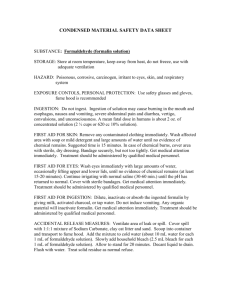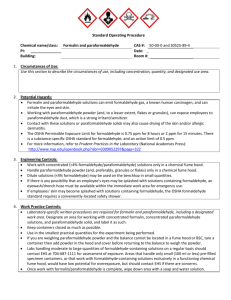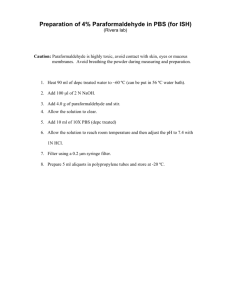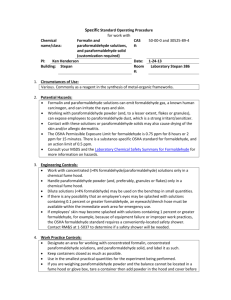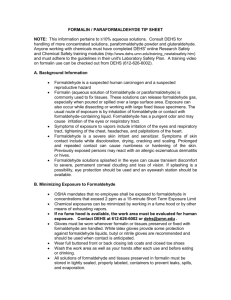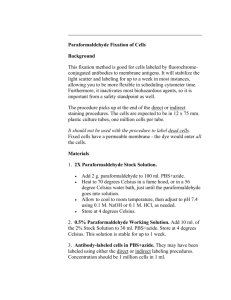SOP template for Formalin and Paraformalin
advertisement
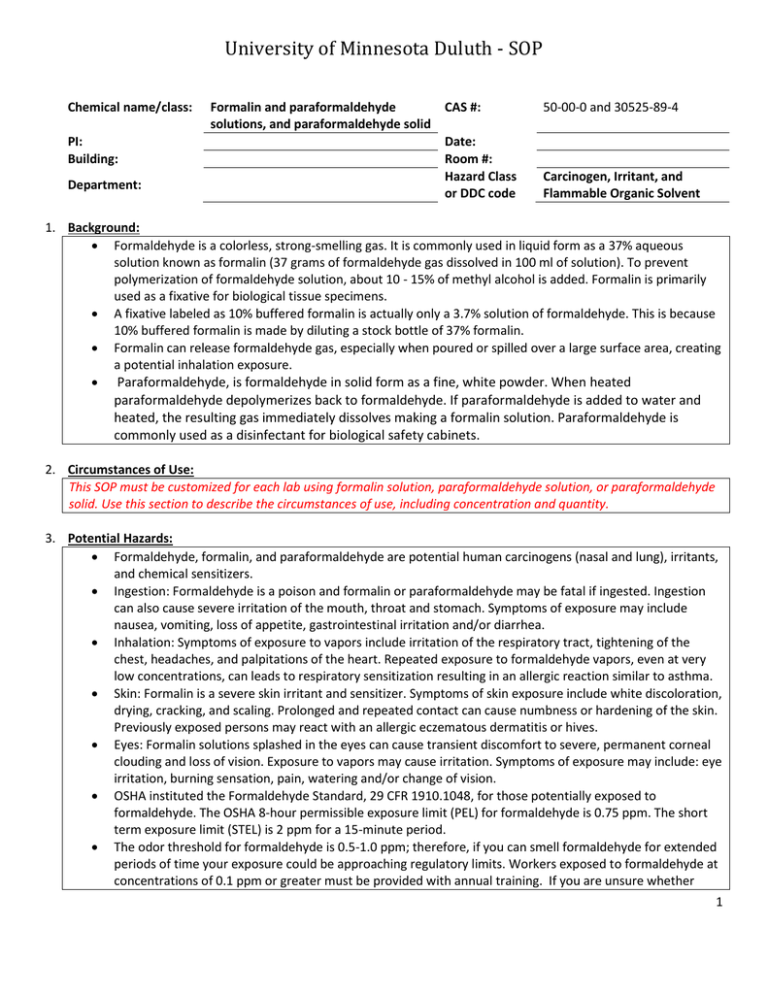
University of Minnesota Duluth - SOP Chemical name/class: PI: Building: Department: Formalin and paraformaldehyde CAS #: solutions, and paraformaldehyde solid Date: Room #: Hazard Class or DDC code 50-00-0 and 30525-89-4 Carcinogen, Irritant, and Flammable Organic Solvent 1. Background: Formaldehyde is a colorless, strong-smelling gas. It is commonly used in liquid form as a 37% aqueous solution known as formalin (37 grams of formaldehyde gas dissolved in 100 ml of solution). To prevent polymerization of formaldehyde solution, about 10 - 15% of methyl alcohol is added. Formalin is primarily used as a fixative for biological tissue specimens. A fixative labeled as 10% buffered formalin is actually only a 3.7% solution of formaldehyde. This is because 10% buffered formalin is made by diluting a stock bottle of 37% formalin. Formalin can release formaldehyde gas, especially when poured or spilled over a large surface area, creating a potential inhalation exposure. Paraformaldehyde, is formaldehyde in solid form as a fine, white powder. When heated paraformaldehyde depolymerizes back to formaldehyde. If paraformaldehyde is added to water and heated, the resulting gas immediately dissolves making a formalin solution. Paraformaldehyde is commonly used as a disinfectant for biological safety cabinets. 2. Circumstances of Use: This SOP must be customized for each lab using formalin solution, paraformaldehyde solution, or paraformaldehyde solid. Use this section to describe the circumstances of use, including concentration and quantity. 3. Potential Hazards: Formaldehyde, formalin, and paraformaldehyde are potential human carcinogens (nasal and lung), irritants, and chemical sensitizers. Ingestion: Formaldehyde is a poison and formalin or paraformaldehyde may be fatal if ingested. Ingestion can also cause severe irritation of the mouth, throat and stomach. Symptoms of exposure may include nausea, vomiting, loss of appetite, gastrointestinal irritation and/or diarrhea. Inhalation: Symptoms of exposure to vapors include irritation of the respiratory tract, tightening of the chest, headaches, and palpitations of the heart. Repeated exposure to formaldehyde vapors, even at very low concentrations, can leads to respiratory sensitization resulting in an allergic reaction similar to asthma. Skin: Formalin is a severe skin irritant and sensitizer. Symptoms of skin exposure include white discoloration, drying, cracking, and scaling. Prolonged and repeated contact can cause numbness or hardening of the skin. Previously exposed persons may react with an allergic eczematous dermatitis or hives. Eyes: Formalin solutions splashed in the eyes can cause transient discomfort to severe, permanent corneal clouding and loss of vision. Exposure to vapors may cause irritation. Symptoms of exposure may include: eye irritation, burning sensation, pain, watering and/or change of vision. OSHA instituted the Formaldehyde Standard, 29 CFR 1910.1048, for those potentially exposed to formaldehyde. The OSHA 8-hour permissible exposure limit (PEL) for formaldehyde is 0.75 ppm. The short term exposure limit (STEL) is 2 ppm for a 15-minute period. The odor threshold for formaldehyde is 0.5-1.0 ppm; therefore, if you can smell formaldehyde for extended periods of time your exposure could be approaching regulatory limits. Workers exposed to formaldehyde at concentrations of 0.1 ppm or greater must be provided with annual training. If you are unsure whether 1 University of Minnesota Duluth - SOP your work area exposures exceed levels which require annual training or additional workplace controls, contact EHSO and request an exposure assessment. 4. Engineering Controls: Work with concentrated (>4% formaldehyde/paraformaldehyde) solutions only in a chemical fume hood. Handle paraformaldehyde powder (and, preferably, granules or flakes) only in a chemical fume hood. Dilute solutions (<4% formaldehyde) may be used on the bench top in small quantities. If there is any possibility that an employee's eyes may be splashed with solutions containing 0.1 percent or greater formaldehyde, an eyewash/drench hose must be available within the immediate work area for emergency use. If employees' skin may become splashed with solutions containing 1 percent or greater formaldehyde, for example, because of equipment failure or improper work practices, the OSHA formaldehyde standard requires a conveniently-located safety shower. Contact EHSO at 218-726-7139 to determine if a safety shower will be needed. 5. Work Practice Controls: If other specific written procedures are required for work with paraformaldehyde and/or formaldehyde solutions, you must list them here or attach a step-by-step procedure. (If no further procedures are needed beyond those listed in this template, you can delete this bullet.) Designate an area for working with concentrated formalin, concentrated paraformaldehyde solutions, and paraformaldehyde solid, and label it as such. Keep containers closed as much as possible. Use in the smallest practical quantities for the experiment being performed. If you are weighing paraformaldehyde powder and the balance cannot be located in a fume hood or BSC, tare a container then add powder in the hood and cover before returning to the balance to weigh the powder. Labs handling moderate to large quantities of formaldehyde-containing solutions on a regular basis should contact EHSO at 218-726-7139 for assessment of exposure. Areas that handle only small (100 ml or less) prefilled specimen containers, or that work with formaldehyde-containing solutions exclusively in a functioning chemical fume hood, would have low potential for overexposure, but should contact OESO if there are concerns. Once work with formalin/paraformaldehyde is complete, wipe down area with a soap and water solution. 6. Personal protective equipment (PPE): Wear standard nitrile laboratory gloves, chemical splash goggles, face shield, and lab coat. If splash may occur, also wear an impervious apron. (OSHA requires that all contact of the eyes and skin with liquids containing 1 percent or more formaldehyde be prevented by the use of chemical protective clothing made of material impervious to formaldehyde and the use of other personal protective equipment, such as goggles and face shields, as appropriate to the operation.) 7. Transportation and Storage: Transport formaldehyde solutions in secondary containment, preferably a polyethylene or other non-reactive acid/solvent bottle carrier. Keep container in cool, well-ventilated area. Keep container tightly closed and sealed until ready for use. Store in secondary containment with flammables, away from oxidizers, reducing agents, metals, and acids. Keep containers of PFA solid away from water. Avoid storing on the floor. 2 University of Minnesota Duluth - SOP Avoid ignition sources. 8. Waste Disposal: Formalin and paraformaldehyde solutions and powders must be disposed of following your laboratoryspecific plan and the requirements of EHSO. Please contact 218-726-7139 to request containers, labels and to arrange for disposal. 9. Exposures/Unintended contact: Flush exposed eyes or skin with water for at least 15 minutes, then seek medical attention. If there is respiratory irritation associated with exposure, remove all persons from the contaminated area and contact the OESO spill team. Call 9911 from a campus phone to request assistance if needed. Contact EHSO at 218-726-7139 for exposurerelated advice. The work-related injury or illness reports can be found at: www.umn.d.edu/ehso/ReportIngPg.html 10. Spill Procedure: Trained employees in the area should be prepared to clean up minor spills, including most spills confined to the chemical fume hood. Wearing double nitrile gloves, splash goggles, face shield and lab coat (and impermeable apron, if available), use absorbent pads to absorb spilled material. (For small spills of solid PFA, dampen the absorbent pad with methanol before placing over the spilled material and allow to sit for a few minutes before wiping up.) After spill has been completely absorbed, wash down contaminated area with soap and water at least two times. Contaminated PPE and clean-up materials must be placed in a clear plastic bag or compatible container for pick-up by EHSO. Large spills or any spill outside the fume hood contact 911 or EHSO at 218-726-7139. NOTE: If there is respiratory irritation associated with exposure, remove all persons from the contaminated area and contact EHSO. Most spills of formalin or paraformaldehyde solutions, or paraformaldehyde powder that occur outside of a chemical fume hood should be referred to EHSO at 218-726-7139. 11. Training of personnel: Annual training is required for any workers exposed to formaldehyde concentrations of 0.1 ppm or greater at the time of initial job assignment and whenever a new exposure to formaldehyde is introduced into the work area. An on-line educational module titled “DEHS Formaldehyde Safety” is available in ULearn. For additional guidance on training, contact EHSO for guidance on appropriate training resources. All personnel shall read and fully adhere to the laboratory-specific SOP for formalin, paraformaldehyde, and paraformaldehyde solutions, and shall document that they have read it by signing and dating the SOP. “I have read and understand this SOP. I agree to fully adhere to its requirements.” Last First ID Signature 3 University of Minnesota Duluth - SOP 4
